Module 6: Chain Saw Use and Safety
Lesson Six - Limbing
LIMBING
Limbing is the systematic removal of branches from a felled tree. Time studies estimate that limbing takes approximately 50 per cent of the time a worker needs to harvest a tree. No doubt those who've harvested white spruce, otherwise called "cat or pasture spruce" will say the figure can be even higher! The fact that so much time is spent limbing means greater chances for accidents.
BASIC GUIDELINES
Modern safety-equipped chainsaws and protective clothing have helped reduce accidents and the severity of injuries. You can reduce the risk of limbing accidents by remembering these basic guidelines:
 Create a Comfortable Working Height
Create a Comfortable Working Height
Plan your work to fell the tree so it's up off the ground. Use a "bench tree", wood pile, hummock, etc. Between knee and hip height is best. This will take the strain off your back.
Lower limbing, bucking, and handling is also easier!
Maintain a Firm Safe Stance 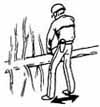
Keep you feet approximately shoulder-width apart and firmly on the ground. Bend your knees slightly.
Never straddle the tree or walk along the trunk. Maintaining your balance at all times is crucial for safe limbing.
 Support the Saw
Support the Saw
Even light-weight chainsaws are heavy after a long day! Always rest the saw on or against the stem. Let the weight of the saw work for you by "levering" it to remove the branches.
Work Close To Your Saw
This is safer and more comfortable and provides better saw control. Never reach with your saw.
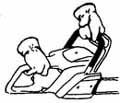 Maintain a Firm Grip
Maintain a Firm Grip
Chainsaws are designed to be used "right-handed." Always keep your left thumb around the front handle. This is important to maintain control of the saw if kickback occurs.
Use Full Throttle
For best results, run your saw at full throttle immediately before cutting. Do not hold the throttle wide open for long periods of time without putting it in wood, since this will damage the engine.

Avoid Cutting With the Tip
Use the flat sections of the guide bar. Dangerous kickback can occur when you limb (or buck) with the nose. Watch out for supporting stems and butt ends.
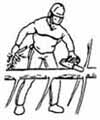 Clear Away Branches Safely
Clear Away Branches Safely
When moving cut branches, hold the saw by the front handle. This reduces the chance of accidentally hitting the throttle.
Never reach across the guide bar! Wait until the chain has stopped, and for added safety put on the chain brake.
 Move Forward Safely
Move Forward Safely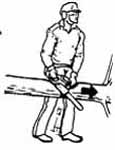
Always keep the stem between you and the guide bar when moving forward.
Check for Branches Under Tension
When a tree is felled, branches are often placed under tension. You can avoid pinching your guide bar by making one or more cuts on the tension side first. Then cut the branch flush with the stem.
Top The Tree Safely
Never reach forward and top the tree by pulling the saw toward yourself. Take the extra step and make this last cut safely to avoid possible kickback. It's a step that may save your life.
Workers have been killed because the saw has kicked back and cut the artery along the inside of their leg.
TECHNIQUES

First let's distinguish between "pushing" and "pulling" chain. The pushing chain refers to the chain on the top of the guide bar while the 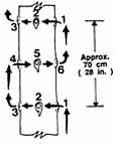 pulling chain refers to the chain on the underside.
pulling chain refers to the chain on the underside.
Lever Method
With the lever method, two important points must be emphasized. First, the saw must be used as a lever while limbing and secondly, the weight of the saw should rest on the stem, not your back. Saw position and work stance permit levering (or pivoting) the saw without any wasted effort. The saw body rests against the stem and your thigh as necessary. The same firm safe stance is used for all six steps.
The lever method works well on stems with closely spaced branch whorls. Always remember to use full throttle.
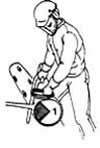 Step 1
Step 1
Rest the saw on the tree with the guide baron the right side. Use the pushing chain to cut all branches in section 1.
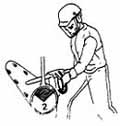
Step 2
Tilt the saw toward yourself, resting the guide bar on top of the stem. Lever the saw using the pushing chain to remove branches in section 2. You may need to lean slightly to the left to make room for the saw.
Step 3
Shift the saw into an upright position. Support the saw body between the tree and your right thigh. Use the pulling chain to cut limbs in  section 3.
section 3.
Step 4
Bring your body weight forward and lever the saw upwards to cut branches in section 4 with the pushing chain. Use your bent knees to help push the saw forward.

Step 5
Shift the saw onto its right side, resting on top of the stem. Lever the guide bar to cut branches in section 5 with the pushing chain. Change your grip to suit the position of the saw. You'll need to use your thumb on the throttle.
 Step 6
Step 6
Return the saw to an upright position, still supporting the saw on the tree. Use the pulling chain to saw downward and remove branches in section 6.
Now, with the saw resting on the tree and guide bar on the opposite side of the stem, it is safe to move forward and begin step 1 again. Follow this six step pattern for the whole length of the tree.
Very few trees will fit this perfect example requiring six steps on every section. Missing branches will allow you to skip some of the steps while branches under tension must be cut separately to avoid jamming the saw. Common sense must be applied when using the lever method.
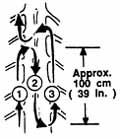 Sweep Method
Sweep Method
With the sweep method, limbs are removed with a sweeping motion in three phases.
It is particularly suited to trees with many small-diameter branches (common in dense stands) or with unevenly spaced branch patterns.
Step 1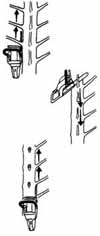
Start with the saw on the left side of the stem. Maintain a balanced stance (similar to the lever method) and support the saw against your right thigh. Make a forward sweep using the pushing chain. Avoid overreaching with the saw and placing strain on your back.
Step 2
Tilt the saw on top of the stem and sweep backward using the pulling chain.
Step 3
Now, tilt the saw with the guide bar down on the right side of the stem. Support the saw on the tree and make a forward sweep using the pushing chain.
Keep the saw on the right side while you move forward. Change the saw to the left side and begin step 1 again. You can use the first three steps of the lever method to bring the saw back to the left side.
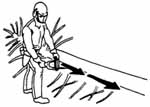 Removing Bottom Branches
Removing Bottom Branches
Generally, limbing bottom branches can be done as each sequence of steps is finished or after the entire tree has been limbed. With the tree at a comfortable working height, lower limbing is much easier and all the branches can be removed in one pass down the tree.
If you prefer lower limbing after each sequence, face the stem and make a short sweep backwards using the pushing chain.
Ensure the bar is flush with the underside of the stem. Support your right forearm or elbow against your right thigh and avoid overextending.
If the stem is close to the ground, top and roll to expose the remaining branches. Then, use the pulling chain while moving backward in small steps. Support the saw on the trunk and always maintain a firm footing. Watch out for hidden stumps or rocks which may damage the chain or cause kickback.
